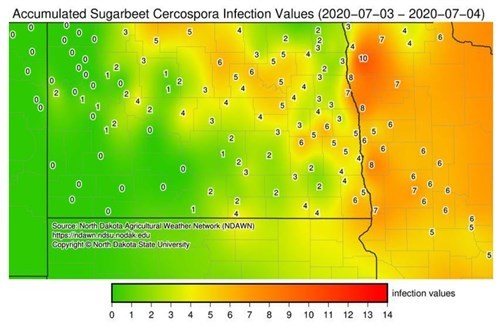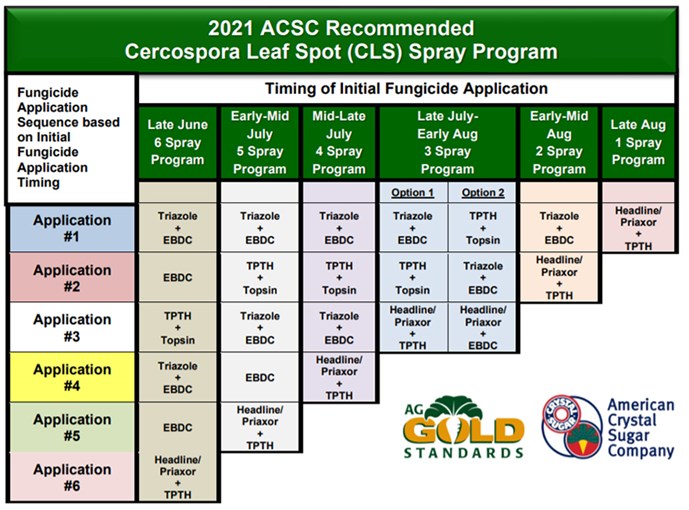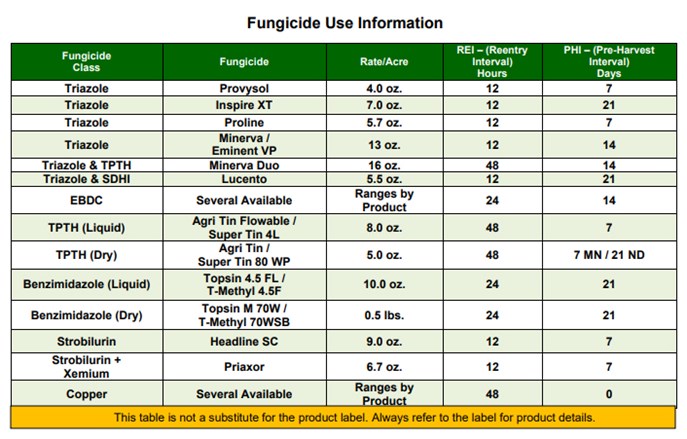620 - American Crystal 2021 Cercospora Control Recommendations
Cercospora Leafspot (CLS) fungicide recommendations incorporate both CLS control and resistance management.
Each recommended fungicide tankmix combines 2 different modes action as well as them being a translaminar/systemic fungicide paired with a contact fungicide.
- Except when EBDC is alone in the 5 & 6 spray programs
- There is no documented resistance to EBDC fungicides
Starting your Cercospora Leaf Spot Spray program: If you think you’re spraying too early, you’re probably right on time.
- There is a robust amount of cercospora inoculum in the environment from the 2020 growing season
- Start program once rows start to close coinciding with Moderate to Severe Daily Infection Value’s. Start early and stay on track.
- After a Cercospora infection occurs, it can take 5 to 21 days for spots to appear on the leaf.
- Fungicides are protectants and are not curatives
- To limit CLS infections, be proactive by applying fungicides to protect the sugarbeet leaves before infections can occur
Tools to Monitor CLS Daily Infection Values
- American Crystal Agronomy App
- Free, found in the “App Store” (Apple) or “Google Play” (Android)
- NDAWN Website



Fungicide Class (Mode of Action) Information
Tankmix and rotate fungicide classes for cercospora control & resistant management
- Do not apply same MOA back-to-back in consecutive applications
- The exception is EBDC in the 5 & 6 spray programs
Triazoles
- Do not use in more than 50% of applications per cropping season and only in a tank-mix.
- Triazoles are vital to CLS management and overuse may further increase resistance.
- Alternate different Triazoles if used more than once in a spray season.
- Due to a high probability of cross-resistant CLS spores if applying just 2 Triazoles per season:
- Do not use both Provysol & Inspire XT in the same growing season.
- Watch Preharvest intervals (PHI’s) for Triazoles, they can range from 7 to 14 to 21 days.
- Consider applying Triazoles with longer PHI’s early in the spray season and shorter PHI’s later in your fungicide program for harvest planning.
EBDC’s (Mancozeb/Manzate):
- Are an effective tank mix partner for CLS control and resistance management.
- There is no known resistance to EBDC’s.
- EBDC is only recommended to be used as a standalone in the 5 or 6 spray programs
- If EBDC is used alone the Spray Interval should not exceed 7 days
- Pre-Slurrying product helps in tank-mixing.
- Manebs are not as effective on CLS as Mancozeb’s.
Tins (TPTH):
- Use in only 2 applications per cropping season and only in a tank-mix.
- Tins are vital to CLS management and overuse may further increase resistance.
- Watch Pre-Harvest intervals (PHI’s) as they range from 7 - 21 days.
Topsin (Benzimidazole):
- Use only once per season early in spray program & only in a tank-mix (e.g. Tins - TPTH).
Headline/Priaxor (Strobilurin):
- Headline/Priaxor benefits include: plant health; harvest frost deterrence/recovery; and storage benefits.
- Use only with a tank mix of Tin (TPTH) at full rate. Exception is in the 3 Spray program under Option 2 where EBDC is used as the tank mix.
Copper
- Coppers have a 0-day Pre-Harvest Interval (PHI), creates an option if up against Pre-Harvest Intervals during pre-pile or before stockpile harvest as a tank-mix partner.
- Ideally tank-mix copper with a non-contact fungicide (Triazole) to avoid two contact fungicides in the same application. Must adhere to the PHI of tank mix partner.
- Talk to your Agriculturist if you are planning to use a Copper product.
WALES tank mixing order for any Pesticide:
- Wettable powders & dispersible granules
- Agitate tank to mix thoroughly
- Liquid flowables & suspensions
- Emulsifiable concentrate formulations
- Surfactants & Solutions
Tips for Maximizing Cercospora Leafspot Control
- CLS variety rating – CLS control should improve with a better CLS variety rating. However, this may not equate to fewer fungicide applications.
- Daily Infection Values – Monitor Daily Infection Values (DIV’s) and weather forecasts for timing initial and following fungicide applications. Found on the Crystal Agronomy App and NDAWN
- Timing of fungicide program – Start program once rows close and coinciding with Moderate to Severe DIV’s. Start early and stay on track. Cercospora Leaf Spot can appear 5 to 21 days after spore infection. Fungicides are protectants and being proactive by applying fungicides ahead of infection limits the development of Cercospora leaf spot.
- Full rates – In tank mixes utilize full application rates of each tank mix partner, following label recommendations.
- Spray intervals – The time interval between applications should not exceed 12 days, plan best as possible around adverse weather conditions (rain, wind, hail). For EBDC’s alone follow a 7-day spray interval.
- Aerial application – If too wet for ground application, stay on schedule with an aerial application.
- Glyphosate tank mixes – Are not recommend with CLS fungicide applications since optimum water volume requirements are different for glyphosate and CLS fungicide applications as the target pests are not the same.
- Pre-Pile & Fungicide Pre-Harvest Intervals – Be aware of each fungicide’s Pre-harvest Interval and how that may impact pre-pile harvest plans. Adjust your fungicide spray program accordingly.
- Water volume – CLS fungicides need excellent coverage to protect the sugarbeet leaf surface. To achieve this requires 15 to 20 gallons of water per acre.
- Pressure – High pressure applications at 80+ psi provides improved leaf coverage depending on the spray tip chosen.
- Spray nozzles/tips & droplet size – Using nozzles that will produce Medium droplet sizes of 250–350µm (microns) is optimum for fungicide applications. Utilize nozzle manufacturer’s recommended application pressure to operate within this range. Use proper spray boom height above crop canopy depending on chosen spray nozzle degree angle for best coverage.
- Tank mixes – All fungicide applications should contain more than one chemistry or mode of action (only exception would be EBDC’s). Tank-mixing fungicide MOA’s and rotating MOA’s are paramount. Using only a single fungicide, MOA, increases resistance development pressure to that fungicide. Single fungicide applications may “get you by” but will increase and compound resistance to fungicides on your farm and surrounding neighbors. Utilizing all available fungicide chemistry wisely is vitally important for current fungicide options today and tomorrow. Any tank mix should be sprayed out as soon as possible, with agitation, do not allow mix to sit overnight, spray tank out completely, and rinse sprayer (all lines and tank) with clean water daily.
- Water temperature – Warm water is best for dissolving & mixing fungicides. Pre-warm water in dark bulk tanks a few days prior to use, sunlight aids in warming the water.
- Jar test – If in doubt about a tank mix, run a jar test to see if combination is compatible before loading sprayer.
- Scout fields – during the growing season to evaluate how your fungicide spray program is working.
